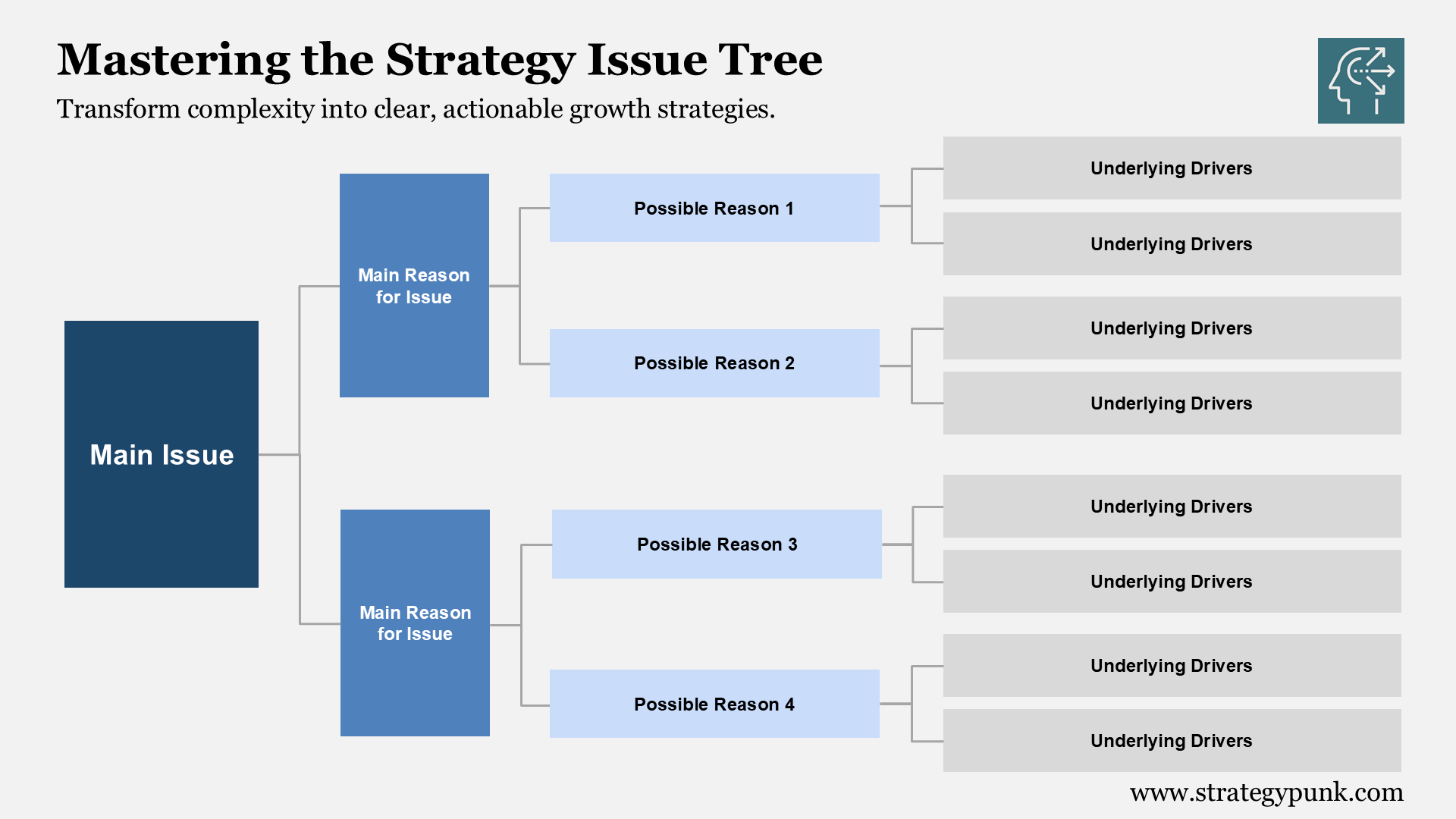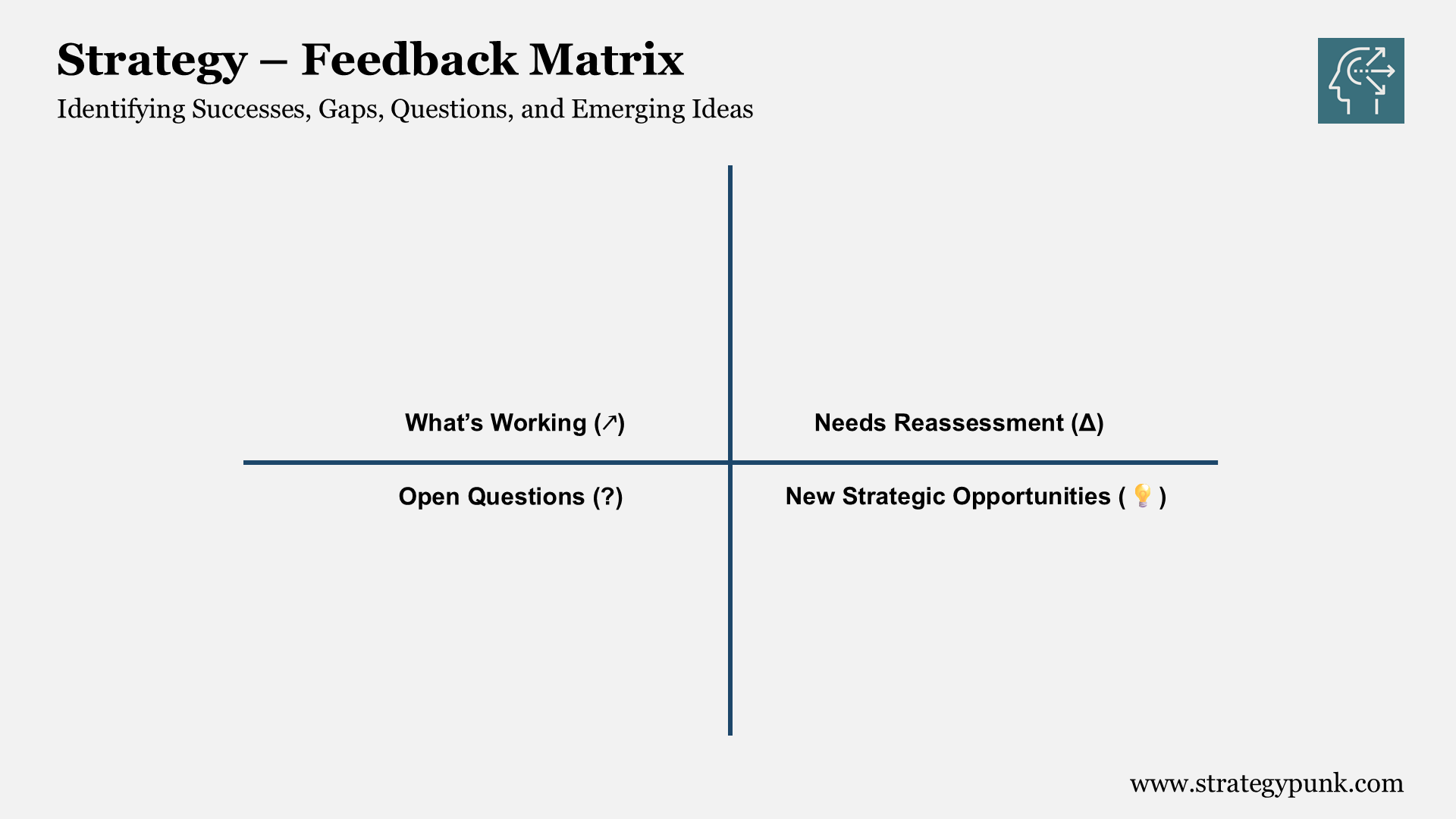SWOT Analysis of Nissan: Free PPT Template and In-Depth Insights 2024
Explore our SWOT Analysis of Nissan Motors for 2024. Free PowerPoint template for strategic planning and presentations.
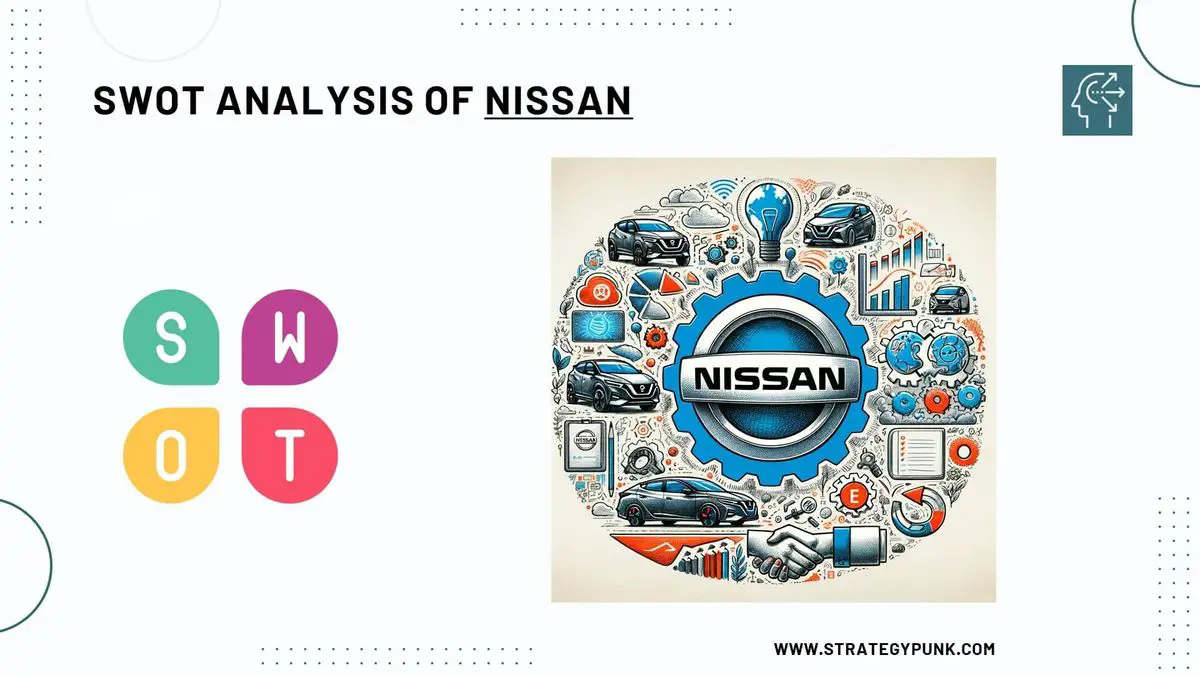
Introduction
Nissan Motors is a leading Japanese automaker with a global presence and a diverse range of vehicles, from affordable compacts to luxury sports cars.
Nissan has faced challenges recently, including declining profits, recalls, natural disasters, and increased competition.
This blog post uses a SWOT framework to examine Nissan's strengths, weaknesses, opportunities, and threats in 2024. It aims to provide strategic insights into Nissan's current position and outlook.
Download our free, editable Nissan SWOT analysis template in PowerPoint to evaluate Nissan's strengths, weaknesses, opportunities, and threats. Customize it easily for your presentations.
Introduction to Nissan Motor
Founded in 1933, Nissan Motor Co., Ltd. is headquartered in Yokohama, Japan, and sells vehicles under the Nissan, Infiniti, and Datsun brands.
Nissan is allied with French automaker Renault, which owns 43% of Nissan. As of 2022, Nissan employs over 130,000 people globally and has manufacturing facilities in Japan, the USA, Mexico, the UK, China, Thailand, Indonesia, India, and other countries.
Nissan sells over 4 million vehicles annually in over 190 countries. The company aims to provide customers with innovative and exciting cars and a fulfilling ownership experience worldwide. As part of its Nissan Ambition 2030 long-term vision, the company is focused on zero-emission vehicles and intelligent mobility technologies.
Nissan's Financials
Nissan Motor Co., Ltd. reported its financial results for the fiscal year ending March 31, 2024, demonstrating significant improvements across key financial metrics compared to the previous fiscal year.
Key Financial Highlights for Fiscal Year 2023:
- Consolidated Net Revenue: Increased by 20% to ¥12.686 trillion, up from ¥10.597 trillion in the previous fiscal year.
- Operating Profit: Rose by 51% to ¥568.7 billion, compared to ¥377.1 billion in fiscal year 2022.
- Operating Profit Margin: Improved to 4.5%, up from 3.6% in the prior year.
- Net Income: Surged by 92% to ¥426.6 billion, a substantial increase from ¥221.9 billion in fiscal year 2022.
- Automotive Net Cash: Stood at ¥1.546 trillion, reflecting a robust financial position.
These positive results are attributed to the successful implementation of the Nissan NEXT business transformation plan, which focused on enhancing sales quality and operational efficiency across key markets. Despite challenges such as intensified sales competition and market fluctuations, Nissan achieved global sales of 3.44 million units.
Looking ahead, Nissan has launched a new business plan, "The Arc," aiming for sustainable and profitable growth by delivering high-value products and services to customers. The company forecasts an operating profit of ¥600 billion and plans to propose an annual dividend of ¥25 or more per share for the next fiscal year.
Source: Nissan News
In-depth SWOT Analysis of Nissan 2024
A SWOT analysis evaluates the internal strengths and weaknesses and external opportunities and threats impacting an organization.
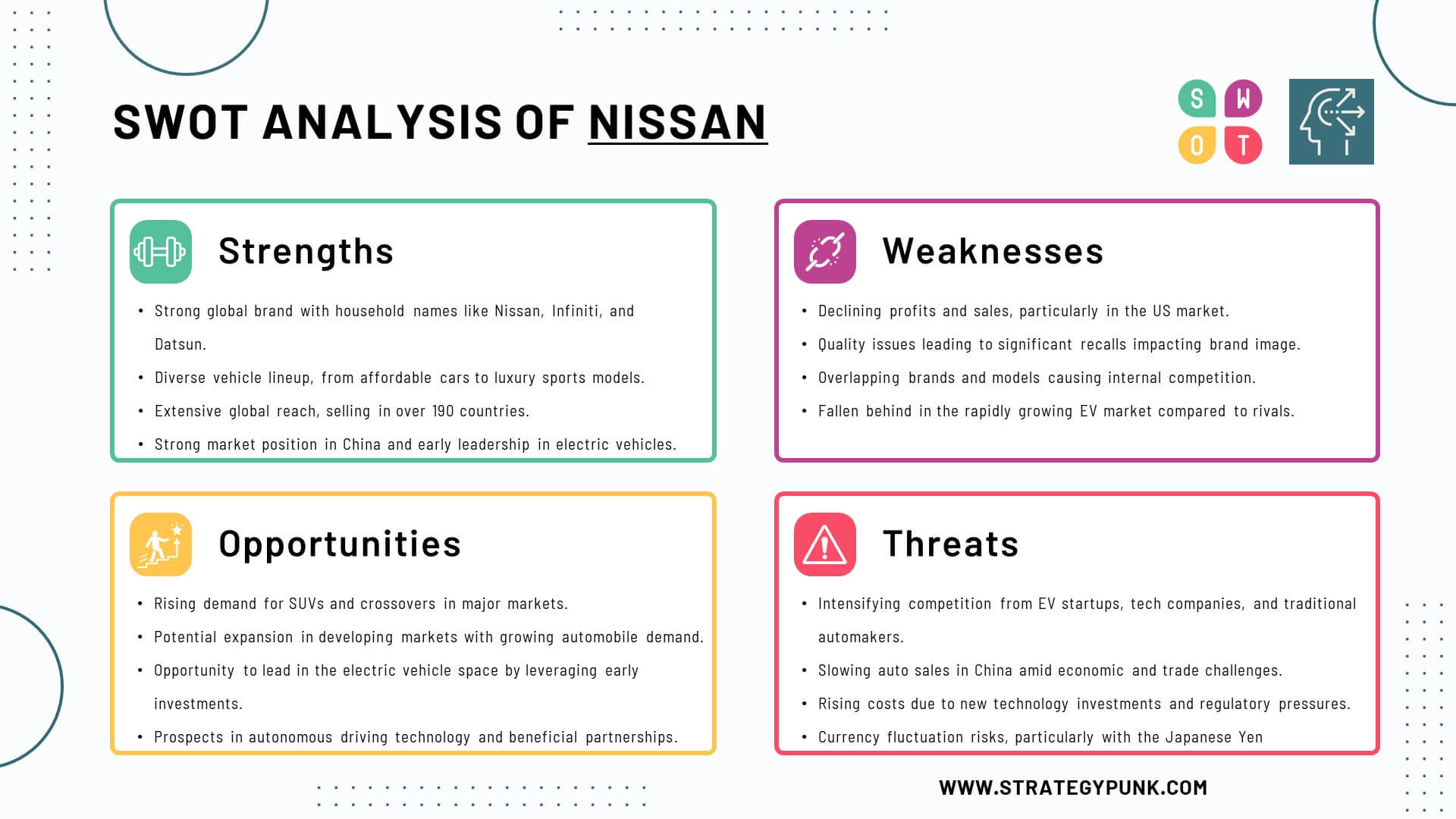
Here is a closer look at Nissan's SWOT in 2024:
Strengths
- Strong brand recognition: Nissan is a well-known global auto brand with a reputation for reliability, innovation, and value across many vehicle segments5. Brands like Nissan, Infiniti, and Datsun are household names in significant markets.
- Broad product portfolio: Nissan has a diverse vehicle lineup, including affordable small and luxury sports cars. Popular models include the Altima, Maxima, Sentra, Leaf, GT-R, Pathfinder, Rogue, Murano, Armada, Frontier, and Titan. This variety caters to different consumer needs.
- Global scale and reach: Nissan sells vehicles in over 190 countries, giving it extensive global scale and reach. Key markets include North America, China, Japan, Europe, and other Asian countries. The global scale provides cost advantages.
- Strong position in China: Nissan has a mover advantage and remains a top foreign auto brand, with over 1.6 million vehicle sales in 2022. China is essential for future growth.
- Investments in EVs: Nissan is an early leader in electric vehicles, launching the Nissan Leaf in 2010. It invests in EVs, autonomous driving, connected cars, and mobility services.
Weaknesses
- Declining profits and sales: Nissan has seen falling revenues and profits since 2018 due to stagnant sales, especially in the US market. It faces intense competition across all vehicle segments.
- Quality issues and recalls: In recent years, Nissan has had some significant recalls related to faulty airbags, braking systems, hood latches, etc., which has hurt the brand image.
- Overlapping brands and models: Nissan's brand portfolio significantly overlaps, with models competing for the same customers. There is a lack of differentiation between Nissan, Infiniti, and Datsun brands.
- Lagging in EVs: Despite early leadership in the fast-growing EV space, Nissan has fallen behind rivals. Competitors like Tesla, VW, GM, and Hyundai offer more EV options.
- Weak position in Europe: Nissan has low brand awareness and sales compared to leading Asian and European automakers. It lacks competitive SUVs and EVs suited for this market.
Opportunities
- Growing SUV and crossover demand: The rising popularity of SUVs and crossovers, especially in the US and China, allows Nissan to tap into fast-growing segments with its models like Rogue, Murano, Pathfinder, and Armada.
- New markets: Nissan can expand in high-growth developing markets like Southeast Asia, Africa, and Latin America, where rising incomes fuel automobile demand.
- EV leadership: By leveraging early EV investments and know-how, Nissan can establish leadership in the surging electric vehicle space and gain market share.
- Autonomous driving: Nissan aims to launch commercially viable autonomous vehicles by 2022. This emerging technology provides growth opportunities.
- Partnerships: Alliance with Renault and Mitsubishi provide cost savings, risk sharing, and technology exchange benefits. Further partnerships can enhance capabilities.
Threats
- Intensifying competition: The auto industry is undergoing rapid transformation. Nissan faces growing competition from new EV startups, tech companies, and traditional automakers5.
- Slowing sales in China: After rapid growth, auto sales are slowing in China due to a weakening economy and trade tensions. This hampers Nissan's prospects in its number two market.
- Rising costs: Investments in new technologies, emission regulations, labor costs, and raw material prices are driving up costs, impacting profit margins industry-wide.
- Japanese Yen appreciation: As a Japanese-based company, Nissan's price competitiveness and export profits are reduced by a stronger yen. Currency fluctuations are an ongoing challenge.
- Macroeconomic factors: Auto sales are cyclical and decline during recessions. Economic slowdowns, rising inflation, higher interest rates, and financial crises in critical markets can hurt sales.
Nissan SWOT Analysis Summary
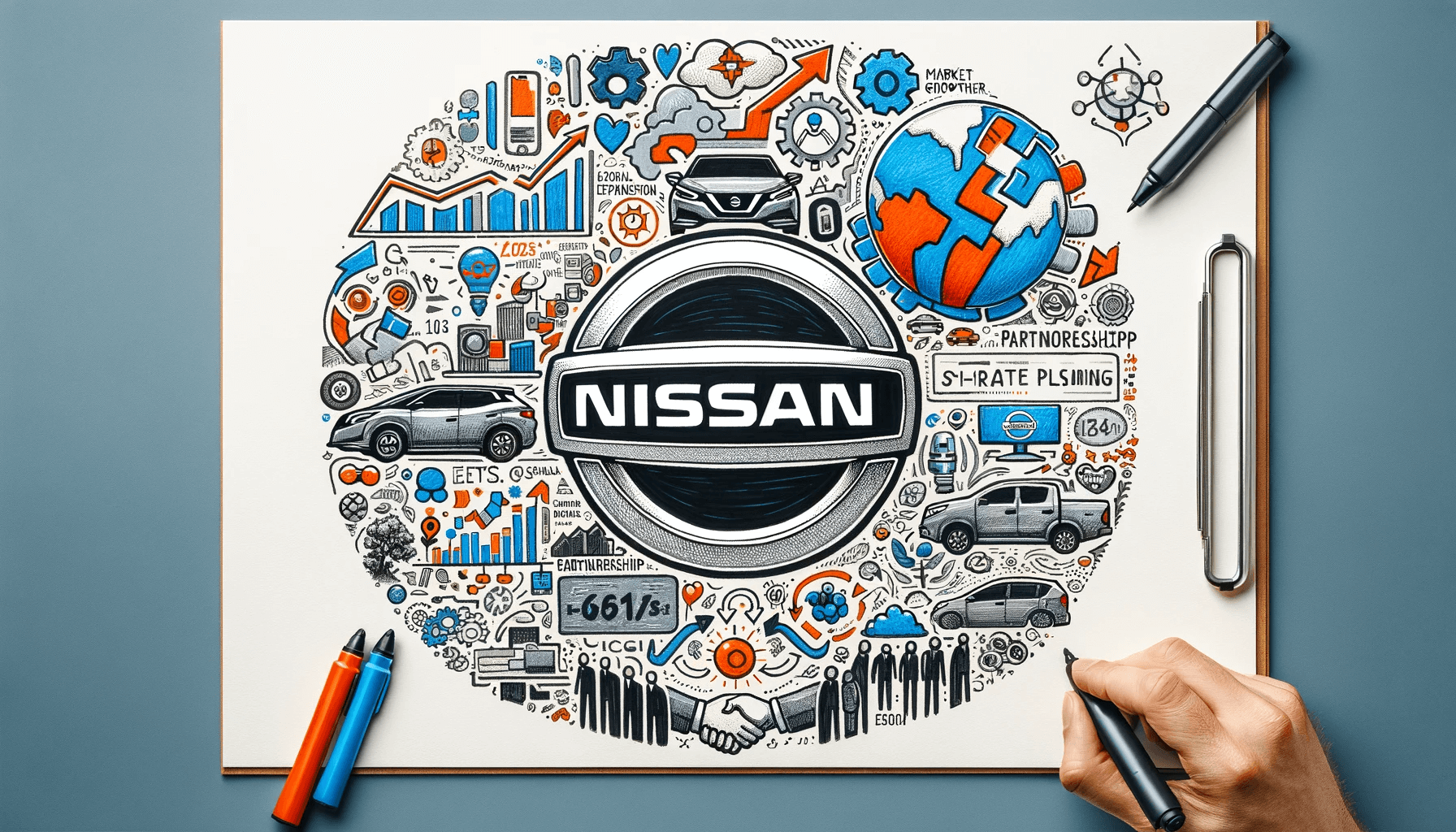
Here's a summarized version of Nissan's SWOT Analysis
| Strengths | Weaknesses |
|---|---|
| 1. Global Brand Recognition | 1. Dependence on Specific Markets |
| 2. Diverse Product Range | 2. Limited Presence in Emerging Markets |
| 3. Innovation in Technology | 3. Recall Issues |
| 4. Strong Production Capabilities | 4. High Operational Costs |
| Opportunities | Threats |
|---|---|
| 1. Growth in Electric Vehicles | 1. Intense Competition |
| 2. Expansion in Emerging Markets | 2. Economic Fluctuations |
| 3. Strategic Alliances | 3. Regulatory Changes |
| 4. Innovation in Autonomous Vehicles | 4. Exchange Rate Volatility |
This table provides a clear and concise overview of the elements in Nissan's SWOT analysis.
What are the main competitors of Nissan?
Nissan's main competitors include:
- Toyota - One of the largest automakers globally and a dominant player in key markets like North America and Asia. Toyota competes with brands like Toyota, Lexus, and Scion across most vehicle segments.
- Honda - A leading Japanese automaker competing with Nissan in segments such as sedans, crossovers, SUVs, and trucks. Honda is strong in North America and Asia.
- Ford - A traditional Detroit automaker and one of the top brands in the US market. Ford offers trucks, SUVs, crossovers, and cars competing with Nissan.
- General Motors (Chevrolet, Buick, GMC, Cadillac) - Another Detroit giant competing in mainstream and luxury segments. GM has a significant global presence.
- Volkswagen - The top European automaker and global leader in segments like compacts, SUVs, and luxury vehicles under brands like VW, Audi, and Porsche.
- Hyundai-Kia - Fast-growing Korean automaker with a reputation for value and strong contenders in segments like compacts, SUVs, and EVs.
- Renault-Nissan-Mitsubishi Alliance - Nissan's alliance partners Renault and Mitsubishi are also competitors in some segments and markets.
Other competitors include Fiat Chrysler, BMW, Mercedes-Benz, Mazda, Subaru, Suzuki, Tata Motors, and emerging EV startups. Nissan faces competition from mass market and luxury brands across geographies.
Frequently Asked Questions
What are Nissan's most significant strengths?
Nissan's significant strengths are its substantial brand equity, global scale and reach, broad vehicle lineup, and early leadership in electric vehicles. It also has a solid presence in growth markets like China and an alliance with Renault and Mitsubishi, providing synergies.
What are the main challenges facing Nissan?
Key challenges include falling profits and sales, recalls hurting brand image, overlapping brands and models, lagging in EVs, intense competition from traditional and new automakers, slowing sales in China, rising costs, and unfavorable currency fluctuations.
What opportunities can Nissan leverage?
Nissan should leverage the growing demand for SUVs/crossovers, expand in developing markets, establish leadership in EVs, commercialize autonomous driving, and pursue new partnerships. It can build on its early EV knowledge.
How can Nissan improve its competitiveness?
Nissan needs to revamp its brand image through quality and innovation. It must control costs, differentiate and streamline its lineup, expand EV options, customize products for local markets, and leverage synergies from its strategic partnerships.
What is Nissan's outlook for the near future?
The outlook for Nissan is challenging, but it has the potential to recover with new leadership, competitive vehicles, and cost-cutting. Its fate depends on successfully executing business transformation initiatives and strategic roadmaps. Alliances and global scale provide advantages.
What are the latest technological advancements in Nissan's electric vehicles?
- New X-in-1 Approach for Electrified Powertrains37 Nissan has developed a modular design approach called "X-in-1" to share and standardize components between EV and e-POWER powertrains. This includes a 3-in-1 prototype combining a motor, inverter, and reducer for EVs and a 5-in-1 prototype adding a generator and increaser for e-POWER hybrids. The approach aims to reduce costs and improve production efficiency.
- Next-generation lithium-ion Batteries. Nissan is working on next-generation lithium-ion batteries, which are expected in the next few years. Goals include reducing costs, increasing energy density to extend range, and enabling faster charging. This will incrementally improve EV battery performance before solid-state introduction.
- Piloting All-Solid-State Batteries4. Nissan plans to start pilot production of all-solid-state batteries by 2025 and introduce them in an EV by 2028. The ASSBs aim to increase energy density further, enable faster charging, reduce size/weight, and improve safety compared to liquid electrolyte lithium-ion batteries.
- Wireless Charging Development. Nissan is developing wireless charging technology to provide more convenient charging. This allows EV charging by simply parking over a charging pad without plugging in.
- New Driver Assistance and Self-Driving Tech. Nissan's ProPILOT driver assistance system is advancing with new capabilities for intersection handling, lane changes, and self-parking. The company is also researching fully autonomous driving technologies.
- Concept Cars Previewing Future Styling/Tech. Nissan has revealed several EV concept cars, like the Surf-Out pickup and Max-Out sports car, providing a glimpse of future products with advanced styling and technology.
Nissan SWOT Analysis PowerPoint Template
free and fully editable PPT template
A SWOT analysis evaluates the strengths, weaknesses, opportunities, and threats impacting a company.
This free editable PowerPoint template provides a SWOT analysis framework to evaluate Nissan's internal strengths and weaknesses and external opportunities and threats.
Download this free, editable PowerPoint SWOT analysis template to evaluate Nissan's strengths, weaknesses, opportunities, and threats. Customize it easily for your presentations.




